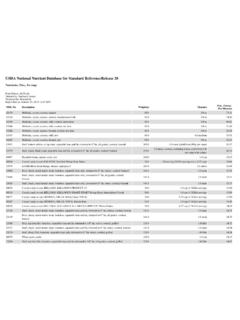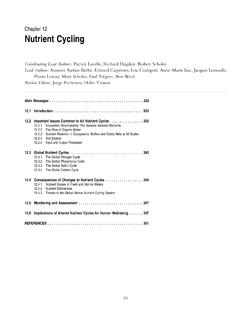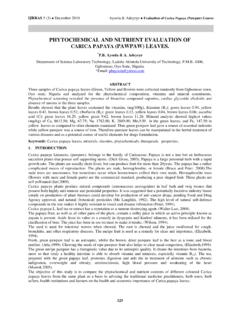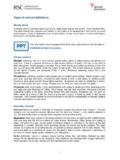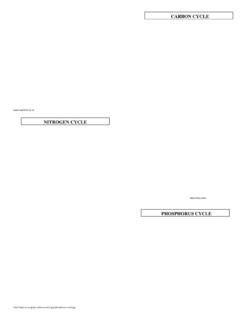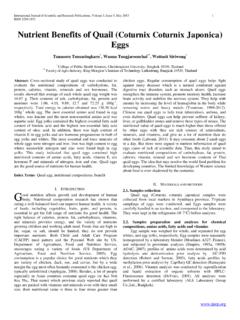Transcription of Nutrient requirements for people living with HIV/AIDS
1 Nutrient requirementsfor people living with HIV/AIDSR eport of a technical consultationWORLD health ORGANIZATIONGENEVA world health organization 2003 All rights reserved. Publications of the world health organization can be obtained fromMarketing and Dissemination, world health organization , 20 Avenue Appia, 1211 Geneva 27, Switzerland (tel: +41 22 791 2476; fax: +41 22 791 4857; Requests for permission to reproduce or translate WHOpublications whether for sale or for noncommercial distribution should be addressedto Publications, at the above address (fax: +41 22 791 4806; email: designations employed and the presentation of the material in this publication donot imply the expression of any opinion whatsoever on the part of the world HealthOrganization concerning the legal status of any country, territory, city or area or of itsauthorities, or concerning the delimitation of its frontiers or boundaries.))
2 Dotted lines onmaps represent approximate border lines for which there may not yet be full mention of specific companies or of certain manufacturers products does not implythat they are endorsed or recommended by the world health organization in preferenceto others of a similar nature that are not mentioned. Errors and omissions excepted, thenames of proprietary products are distinguished by initial capital world health organization does not warrant that the information contained in thispublication is complete and correct and shall not be liable for any damages incurred as aresult of its by minimum graphicsPrinted in FranceWHO Library Cataloguing-in-Publication DataWHO Technical Consultation on Nutrient requirements for people Livingwith HIV/AIDS (2003: Geneva, Switzerland) Nutrient requirements for people living with HIV/AIDS : report of atechnical consultation, world health organization , Geneva, 13 15 immunodeficiency syndrome therapy infections therapy requirements therapy metabolism metabolism drug effects 92 4 159119 6(NLM classification.)
3 WC )ContentsAbbreviations and acronymsivIntroduction1 Conclusions and recommendations3 Macronutrients4 Energy4 Protein6 Fat6 Micronutrients7 Multiple micronutrient supplements9 Nutrition and antiretroviral therapy11 Knowledge gaps and research needs11 References14 Annex A. List of participants19 Annex B. Agenda25iiiAbbreviations and acronymsiiiAEEA ctivity-related energy expenditureAIDSA cquired immunodeficiency syndromeARTA ntiretroviral treatmentCD4 Main target cells for HIV, the number of which decreasesduring HIV infectionFAOFood and Agriculture organization of the UnitedNationsHIVH uman immunodeficiency virusIAEAI nternational Atomic Energy AgencyIUInternational unitsPLWHAP eople living with HIV/AIDSRDAR ecommended daily allowanceREER esting energy expenditureTAGWHO Technical Advisory Group onNutrition and HIV/AIDSTEET otal energy expenditureUNAIDSThe Joint United Nations Programme on HIV/AIDSUNICEFU nited Nations Children s FundWFPW orld Food ProgrammeWHOW orld health Organization1 IntroductionThe objectives of WHO s first technical consultation on NutrientRequirements for people living with HIV/AIDS (PLWHA) (Geneva,13 15 May 2003)
4 Were: to review the relationship between nutrition and HIV/AIDS infection; to review the scientific evidence on the role of nutrition in HIVtransmission, disease progression and morbidity; to review recommendations related to nutritional requirements forPLWHA; to identify research priorities to support improved policies consultation included members of the WHO Technical AdvisoryGroup on Nutrition and HIV/AIDS1 and 20 experts from a variety ofdisciplines and agencies, including universities, governmental andnongovernmental organizations, training institutions in countries highlyaffected by the HIV epidemic, and organizations of the United Nationssystem with food, nutrition and HIV programmes (see Annex A for listof participants).To facilitate the discussions at the meeting, five background paperswere prepared: the effects of HIV/AIDS on energy metabolism;1 WHO has established the Technical Advisory Group on Nutrition and HIV/AIDS asthe principal international technical body responsible for making recommendations tothe Director-General of WHO for appropriate action in national and requirements for people living with HIV/AIDS micronutrients and HIV infection, current knowledge, metho-dological issues and research priorities; micronutrients and HIV-1 disease progression among adults andchildren; nutrition considerations in the use of antiretroviral drugs inresource-limited settings.
5 The role of nutrition interventions in the prevention of HIV infectionand progression of issues relating to nutrition and HIV/AIDS were presented anddiscussed in plenary (see Annex B for agenda of the meeting) based onthree technical themes: nutrition, infection and HIV/AIDS ; nutritional disorders in HIV infection and their implications forestablishing dietary guidelines and recommendations; nutrition interventions and this basis, working groups sought to achieve consensus on macro- Nutrient and micronutrient requirements for both asymptomatic andsymptomatic PLWHA in the light of the following questions: What is the scientific evidence to support nutrition s role in diseaseprevention, and in the care and treatment of PLWHA, and is theevidence sufficient to formulate recommendations? What approaches can be effective in improving the health , nutritionand related outcomes in PLWHA?
6 What are the critical gaps in knowledge? What additional research is needed?Within this perspective, the needs of four target groups were considered: pregnant and lactating HIV-infected women; adolescents and other adults living with HIV; HIV-infected infants and children; HIV-exposed infants and children born to HIV-positive formulated conclusions and recommendations, which werefurther reviewed, consolidated and refined by the members of the WHOT echnical Advisory Group (TAG).3 Conclusions andrecommendations Adequate nutrition, which is best achieved through consumption of abalanced healthy diet, is vital for health and survival for all individuals regardlessof HIV HIV/AIDS epidemic has had a devastating impact on health ,nutrition, food security and overall socioeconomic development incountries that have been greatly affected by the disease.
7 There is anurgent need for renewed focus on and use of resources for nutrition asa fundamental part of the comprehensive package of care at the and investment to improve the nutrition of PLWHA shouldbe based on sound scientific evidence, local resources, and programmaticand clinical experience with the prevention, treatment, and managementof the disease and related infections. Although there are gaps in scientificknowledge, much can and should be done to improve the health ,nutrition and quality of care for PLWHA and their families HIV/AIDS epidemic is occurring in populations where mal-nutrition is already endemic. As an urgent priority, greater political,financial and technical support should be provided for improving dietaryquality and increasing dietary intake to recommended levels. In addition,focused evidence-based nutrition interventions should be part of allnational AIDS control and treatment counselling, care and support interventions for PLWHA will vary according to nutritional status and the extent of disease4 Nutrient requirements for people living with HIV/AIDS progression (recommendations for specific Nutrient requirements aregiven below).
8 HIV-related infections, such as tuberculosis and diarrhoea,not only have nutritional status as a significant determinant of theirincidence and severity, but they also have severe nutritional consequencesthat commonly precipitate appetite loss, weight loss and wasting. Promptdiagnosis and treatment of these conditions, including use of anti-retroviral treatment (ART) when indicated, can contribute to improvednutrition and health . Improved understanding of nutrition/druginteractions is needed to inform HIV/AIDS treatment Energy requirements are likely to increase by 10% to maintain body weightand physical activity in asymptomatic HIV-infected adults, and growth inasymptomatic children. During symptomatic HIV, and subsequently during AIDS, energy requirementsincrease by approximately 20% to 30% to maintain adult body weight.
9 Energy intakes need to be increased by 50% to 100% over normal require-ments in children experiencing weight point to low energy intake combined with increased energydemands due to HIV infection and related infections as the major drivingforces behind HIV-related weight loss and wasting. Based on increasedresting energy expenditure (REE) observed in studies of HIV-infectedadults, it is recommended that energy be increased by 10% over acceptedlevels for otherwise healthy people . The goal is to maintain body weightin asymptomatic HIV-infected adults. Although studies of energyexpenditure have not shown an increase in total energy expenditure(TEE), this may have been the result of individuals compensating byreducing activity-related energy expenditure (AEE). Since maintainingphysical activity is highly desirable for preserving quality of life andmaintaining muscle tissue, it is undesirable that energy intake shouldonly match a reduced level of AEE.
10 The estimated energy requirement5therefore allows for normal AEE levels on top of an increased level energy intake of about 20% to 30% is recommended foradults during periods of symptomatic disease or opportunistic infectionto maintain body weight. This takes into account the increase in REEwith HIV-related infections. However, such intakes may not be achievableduring periods of acute infection or illness, and it has not been proventhat such high intake levels can be safely achieved during such , it is recognized that physical activity may be reduced duringHIV-related infections and the recommended increased intake is basedon the energy needed to support weight recovery during and after HIV-related illnesses. Intakes should therefore be increased to the extentpossible during the recovery phase, aiming for the maximum achievableup to 30% above normal intake during the acute are few studies on energy expenditure in HIV-infected requirements in children can vary according to the type andduration of HIV-related infections, and whether there is weight lossalong with acute infection.










